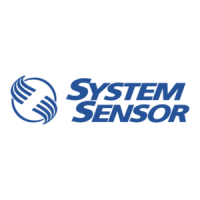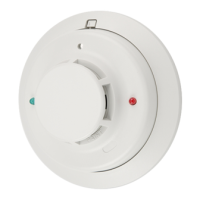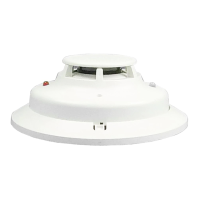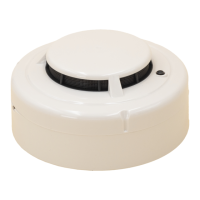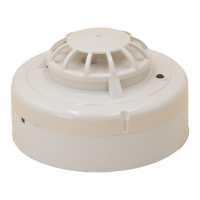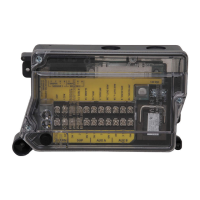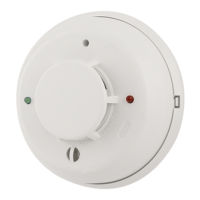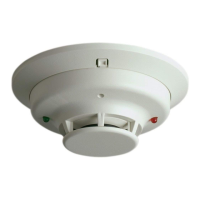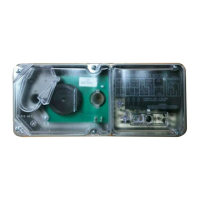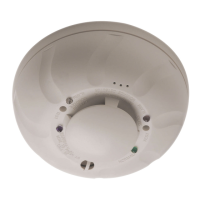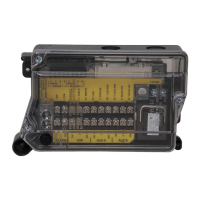D400-50-00 4 I56-612-03
© System Sensor 1996
Three-Year Limited Warranty
System Sensor warrants its enclosed base to be free from defects in materi-
als and workmanship under normal use and service for a period of three
years from date of manufacture. System Sensor makes no other express
warranty for this base. No agent, representative, dealer, or employee of the
Company has the authority to increase or alter the obligations or limita-
tions of this Warranty. The Company’s obligation of this Warranty shall be
limited to the repair or replacement of any part of the base which is found
to be defective in materials or workmanship under normal use and service
during the three year period commencing with the date of manufacture.
After phoning System Sensor’s toll free number 800-SENSOR2 (736-7672)
for a Return Authorization number, send defective units postage prepaid
to: System Sensor, Repair Department, RA #__________, 3825 Ohio Av-
enue, St. Charles, IL 60174. Please include a note describing the malfunc-
tion and suspected cause of failure. The Company shall not be obligated to
repair or replace units which are found to be defective because of damage,
unreasonable use, modifications, or alterations occurring after the date of
manufacture. In no case shall the Company be liable for any consequential
or incidental damages for breach of this or any other Warranty, expressed
or implied whatsoever, even if the loss or damage is caused by the
Company’s negligence or fault. Some states do not allow the exclusion or
limitation of incidental or consequential damages, so the above limitation
or exclusion may not apply to you. This Warranty gives you specific legal
rights, and you may also have other rights which vary from state to state.
The sounder in this base will not operate if the power is cut off for any
reason.
The sounder may not be heard. The loudness of the sounder meets or
exceeds the current standards. However, the sounder may not alert a
sound sleeper or one who has recently used drugs or has been drinking
alcoholic beverages. This sounder may not be heard if it is placed in an
area which is separated by a closed door, or if it is located on a different
floor from the person in a hazardous situation, or if it is placed too far
away to be heard over the ambient noise such as traffic, air conditioners,
machinery, or musical appliances that may prevent alert persons from
hearing the alarm.
The sounder may not be heard by persons who are hearing impaired.
In this case, a visual indicator shall also be used.
This smoke detector used with this base is designed to activate and ini-
tiate emergency action, but will do so only when used in conjunction with
an authorized fire alarm system. This detector must be installed in accor-
dance with NFPA standard 72.
Smoke detectors will not work without power. AC or DC powered
smoke detectors will not work if the power supply is cut off .
Smoke detectors will not sense fires which start where smoke does not
reach the detectors. Smoldering fires typically do not generate a lot of
heat which is needed to drive smoke up to the ceiling where the smoke
detector is usually located. For this reason, there may be large delays in
detecting a smoldering fire with either an ionization-type detector or a
photoelectronic-type detector. Either one of them may alarm only after
flaming has initiated, which will generate the heat needed to drive the
smoke to the ceiling.
Smoke from fires in chimneys, in walls, on roofs, or on the other side of a
closed door may not reach the smoke detector and alarm it. A detector
cannot quickly detect, or sense at all, a fire developing on another level of
a building. For this reason, detectors shall be located on every level and
in every bedroom within a building.
Smoke detectors have sensing limitations, too. Ionization detectors and
photoelectronic detectors are required to pass fire tests of the flaming and
smoldering types. This is to ensure that both can detect a wide range of
fires. Ionization detectors offer a broad range of fire-sensing capability, but
they are somewhat better at detecting fast-flaming fires than slow-smol-
dering fires. Photoelectronic detectors sense smoldering fires better than
flaming fires, which have little, if any, visible smoke. Because fires develop
in different ways, and are often unpredictable in their growth, neither type
of detector is always best, and a given detector may not always provide
early warning of a specific type of fire.
In general, detectors cannot be expected to provide warnings for fires re-
sulting from inadequate fire protection practices, violent explosions, es-
caping gases that ignite, improper storage of flammable liquids like
cleaning solvents that ignite, other similar safety hazards, arson, smoking
in bed, children playing with matches or lighters, etc. Smoke detectors
used in high air velocity conditions may have a delay in alarm due to dilu-
tion of smoke densities created by frequent and rapid air exchanges. Addi-
tionally, high air velocity environments may create increased dust
contamination, demanding more frequent detector maintenance.
Smoke detectors cannot last forever. Smoke detectors contain electronic
parts. Even though detectors are made to last over 10 years, any part can
fail at any time. Therefore, smoke detectors shall be replaced after being in
service for 10 years. The smoke detector system that this detector is used
in must be tested regularly per NFPA 72. This smoke detector should be
cleaned regularly per NFPA 72 or at least once a year.
WARNING
The Limitations of Property Protection Smoke Detectors
Testing
Before testing, notify the proper authorities that the smoke
detector system is undergoing maintenance and that the
system will be temporarily out of service. Disable the zone
or system undergoing maintenance to prevent unwanted
alarms.
Detectors and bases must be tested after installation and
following periodic maintenance.
Test the B401BH/B401BHA as follows:
1. Test the conventional detector head following the proce-
dure in its manual. The B401BH/B401BHA should sound
approximately 10 seconds after the detector alarms.
2. Reverse the polarity of the external 24 VDC supply. This
should cause every base in the loop to sound after ap-
proximately 10 seconds.
Technical Manuals Online! - http://www.tech-man.com
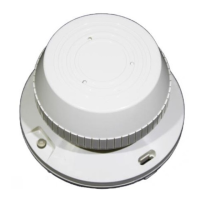
